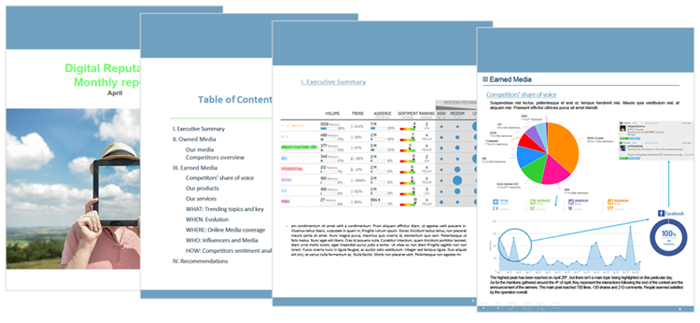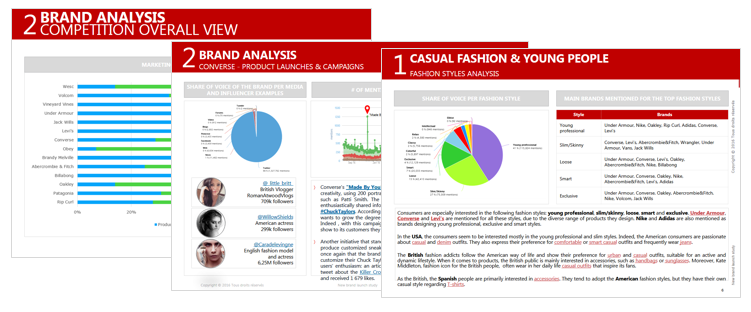5 Essential Social Media Reporting Strategies
Digital marketers and community managers are often responsible for managing and analyzing the performance of social media strategies, in addition to creating reports aimed at evaluating the ROI of their campaigns and events. These reports analyze many KPIs including earned media placements, owned media performance, and search engine reputation across mainstream engines like Google.
In this following article, we will examine five of the most common types of reports used by marketers, advertisers, and agencies:
- Social Media Tracking
- Campaign Reporting
- ROI Reporting
- Brand and Market Audits
- Post-Crisis Assessment
1. Social Media Tracking
The purpose of a social media report is to analyze the strategies, actions, and performance of a company and its competitors - generally speaking, this kind of report occurs on a weekly or monthly basis.
A social media report presents qualitative and quantitative analysis, graphics, and significant trends. In general, a social media strategy report will be presented in a powerpoint, PDF document, or within Excel. Some companies have begun integrating real-time, dynamic dashboards which report on these metrics in real time.
Key Topics:
- Owned Media: evaluates community performance, engagement, and benchmarks progress. The KPIs for this metric are number of followers, number of interactions, and the level of success of published content. Criteria for evaluating the success of owned media performance include all branded social media accounts, their previous performance, and competitor performance.
- Earned Media: evaluation of key messaging points, prominent themes, social media channels, message issuers, and their tone. The KPIs for this metric are reach, interactions, volume of mentions, share of voice, and influence. Criteria for evaluating the success of earned media performance include channel, theme, previous performance, and the performance of competitors.
 An excerpt from a monthly social media report; the text and data have been voluntarily anonymized.
An excerpt from a monthly social media report; the text and data have been voluntarily anonymized.
2. Campaign Reporting
A campaign report is primarily aimed at summarizing the highlights, progresses, and successes of a campaign or event. Campaign tracking is useful for accurate monitoring of marketing efforts both on and offline, including paid social media campaigns, email marketing, events, and media placements. Depending on the nature of the campaign, the periodicity of the tracking might occur as often as one to three times per day. Generally, these reports present both quantitative and qualitative data and often include graphical analyses.
A comprehensive end-of-campaign report will summarize, among other things, key campaign indicators, messaging, and graphical analysis of the campaign’s primary efforts. To ensure successful tracking, all necessary elements, including messaging, KPIs, and data collection should be set up prior to the beginning of the campaign’s launch. For example, a social media campaign might track the engagement levels of owned media, growth in number of followers, reach of owned media, key transmitters and messaging, and finally recommendations for improvement. While a campaign report should absolutely include quantitative analysis, it should prioritize prescriptive analysis.
3. ROI Reporting
An ROI report presents the direct results of various marketing actions and is intended to highlight the successes and failures of marketing efforts in order to determine where investment should be continued, cut, or increased. This type of report is generally on a created monthly, quarterly, or annual basis.
Key Topics:
The report primarily compares the budgets committed and the results obtained - other topics include:
- Reallocation of the budget for content, website, blog, social media, webinars, etc.
- Achievement of objectives
- Results by reach, interaction rates, lead generation, cost per click, cost per MQL
- Recommendations for improvement
Bonus: Track, measure and prove social ROI with these objectives and metrics.
4. Brand and Market Audit
An internal audit is intended to benchmark a brand’s position within their sector before the launch of a campaign, before investing in a new project, or to explore a potential market entrance or competitive environment.
To more fully understand a brand’s performance within its sector, it's necessary to perform a comprehensive competitive benchmark. Brands may be evaluated by the following indicators: community performance, engagement rates, growth in followers, competitor performance, key conversation channels, or influencer mapping.
 A sample market positioning audit for a brand within the youth fashion industry.
A sample market positioning audit for a brand within the youth fashion industry.
5. Post-Crisis Assessment
The intent behind any form of crisis management is to inform all internal stakeholders and to inform those responsible for external communications of potential threats. The primary stakeholders are the communications managers, marketing managers, social media coordinators, customer-success managers and so on. The periodicity for crisis reporting is highly variable depending on the nature of the crisis situation and its severity. A crisis report will generally present both quantitative and qualitative data and is often complemented with a tracking dashboard updated in real-time.
Key Topics:
A crisis management report should focus on elements which enable a brand to assess the severity of threats. Some examples include the volume of negative mentions, the reach of those mentions, general tone of brand-relevant discussion, the types of transmitters, and prominent channels.
Across owned media, the areas of concern are the number of negative brand interactions and the interaction rates among these posts. For earned media, brands might monitor key topics of discussion, dominant conversation channels, number of mentions, share of voice amongst issuers, the reputation of the journalistic outlets, and so on.
These reports, regardless of their objectives, should offer consistent and useful feedback. Additionally, those responsible for creating these reports should consistently seek feedback on both the presentation and content of these reports.
.png?width=100&name=logo%20(1).png)


